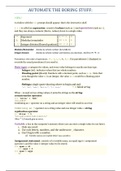Summary
Information & Data Management: SUMMARY Automate The Boring Stuff with Python
- Course
- Institution
- Book
English summary for the course Information & Data Management of the bachelor Business Administration at the UvA. It includes all the required chapters of 'How to automate the boring stuff with Python' and some additional lecture notes. If you read this you will understand Python and programming way...
[Show more]




